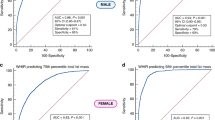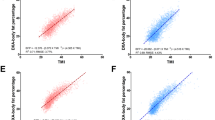Abstract
OBjective:
To examine the associations between the adiposity-related information conveyed by field fatness measures: body mass index (BMI), waist circumference (WC) and sum of triceps and subscapular skinfolds (SUM SF) relative to dual-energy X-ray absorptiometry (DXA), beyond their common intercorrelations, with three important metabolic variables in US adolescents.
Methods:
We analyzed data on adiposity and insulin resistance (HOMA-IR), serum triglycerides (TGs) and total cholesterol (TC) from three US national surveys. In two-stage least-square modeling, we first calculated the common adiposity variance, and then used multivariate linear and quantile regressions to access residual associations with each measure.
Results:
Basic associations for each of the adiposity measures were similar but differences emerged in residual adiposity analyses scaled by s.d. units. While a 1 s.d. change in residual variance in DXA total fat beyond that accounted for by BMI (DXA|BMI) was strongly and significantly associated with all outcomes, associations with DXA accounting for SUM SF (DXA|SUM SF) and WC (DXA|WC) were weak or nonsignificant. Contrasted amongst themselves, the residual score association between BMI|SUM SF (β=0.06, P<0.0001) and HOMA-IR was weaker, and half as strong as that for the converse, SUM SF|BMI (β=0.13, P=0.020). SUM SF|WC was stronger than WC|SUM SF (β=0.08, P<0.0001 vs SUM SF|WC β=0.13, P<0.0001). Associations were similar for TGs and TC.
Conclusions:
Laboratory methods like DXA offer minimal explanatory advantage over field methods in assessing adiposity-related contributions to metabolic outcomes in adolescents. Among the simple fatness measures, skinfolds convey additional information beyond BMI and WC when estimating associations both at the population mean and at the upper extremes of metabolic factors.
This is a preview of subscription content, access via your institution
Access options
Subscribe to this journal
Receive 12 print issues and online access
$259.00 per year
only $21.58 per issue
Buy this article
- Purchase on Springer Link
- Instant access to full article PDF
Prices may be subject to local taxes which are calculated during checkout
Similar content being viewed by others
References
Gregori D, Foltran F, Ghidina M, Zobec F, Berchialla P . Familial environment in high- and middle-low-income municipalities: a survey in Italy to understand the distribution of potentially obesogenic factors. Public Health 2012; 126: 731–739.
Yee KE, Eisenmann JC, Carlson JJ, Pfeiffer KA . Association between the family nutrition and physical activity screening tool and cardiovascular disease risk factors in 10-year old children. Int J Pediatr Obes 2011; 6: 314–320.
Martinez-Vizcaino V, Ortega FB, Solera-Martinez M, Ruiz JR, Labayen I, Eensoo D et al. Stability of the factorial structure of metabolic syndrome from childhood to adolescence: a 6-year follow-up study. Cardiovasc Diabetol 2011; 10: 81 2840-10-81.
Camhi SM, Katzmarzyk PT . Tracking of cardiometabolic risk factor clustering from childhood to adulthood. Int J Pediatr Obes 2010; 5: 122–129.
Camhi SM, Katzmarzyk PT, Broyles S, Srinivasan SR, Chen W, Bouchard C et al. Predicting adult body mass index-specific metabolic risk from childhood. Metab Syndr Relat Disord 2010; 8: 165–172.
Freedman DS, Katzmarzyk PT, Dietz WH, Srinivasan SR, Berenson GS . Relation of body mass index and skinfold thicknesses to cardiovascular disease risk factors in children: the Bogalusa heart study. Am J Clin Nutr 2009; 90: 210–216.
Mueller NT, Pereira MA, Buitrago-Lopez A, Rodriguez DC, Duran AE, Ruiz AJ et al. Adiposity indices in the prediction of insulin resistance in prepubertal Colombian children. Public Health Nutr 2013; 16: 248–255.
Demerath EW, Schubert CM, Maynard LM, Sun SS, Chumlea WC, Pickoff A et al. Do changes in body mass index percentile reflect changes in body composition in children? Data from the Fels longitudinal study. Pediatrics 2006; 117: e487–e495.
Freedman DS, Wang J, Maynard LM, Thornton JC, Mei Z, Pierson RN et al. Relation of BMI to fat and fat-free mass among children and adolescents. Int J Obes (Lond) 2005; 29: 1–8.
Vazquez G, Duval S, Jacobs Jr DR, Silventoinen K . Comparison of body mass index, waist circumference, and waist/hip ratio in predicting incident diabetes: a meta-analysis. Epidemiol Rev 2007; 29: 115–128.
Wang H, Story RE, Venners SA, Wang B, Yang J, Li Z et al. Patterns and interrelationships of body-fat measures among rural Chinese children aged 6 to 18 years. Pediatrics 2007; 120: e94–e101.
Sarria A, Garcia-Llop LA, Moreno LA, Fleta J, Morellon MP, Bueno M . Skinfold thickness measurements are better predictors of body fat percentage than body mass index in male Spanish children and adolescents. Eur J Clin Nutr 1998; 52: 573–576.
Mason C, Katzmarzyk PT . Waist circumference thresholds for the prediction of cardiometabolic risk: is measurement site important? Eur J Clin Nutr 2010; 64: 862–867.
Addo OY, Pereira MA, Himes JH . Comparability of skinfold thickness to DXA whole-body total fat in their associations with serum triglycerides in youths. Eur J Clin Nutr 2012; 66: 989–993.
Steinberger J, Jacobs DR, Raatz S, Moran A, Hong CP, Sinaiko AR . Comparison of body fatness measurements by BMI and skinfolds vs dual energy X-ray absorptiometry and their relation to cardiovascular risk factors in adolescents. Int J Obes (Lond) 2005; 29: 1346–1352.
Mehdad S, Hamrani A, El Kari K, El Hamdouchi A, Barakat A, El Mzibri M et al. Body mass index, waist circumference, body fat, fasting blood glucose in a sample of moroccan adolescents aged 11–17 years. J Nutr Metab 2012; 2012: 510458.
Reilly JJ . Assessment of obesity in children and adolescents: synthesis of recent systematic reviews and clinical guidelines. J Hum Nutr Diet 2010; 23: 205–211.
Freedman DS, Ogden CL, Blanck HM, Borrud LG, Dietz WH . The abilities of body mass index and skinfold thicknesses to identify children with low or elevated levels of dual-energy X-ray absorptiometry-determined body fatness. J Pediatr 2013; 163: 160–166.
CDC/NCHS. The National Health and Nutrition Examination Survey. 2012; Available at http://www.cdc.gov/nchs/nhanes.htm (accessed August, 2013).
CDC/NCHS. Survey Design Factors. 2010; Available at http://www.cdc.gov/nchs/tutorials/nhanes/SurveyDesign/intro.htm (accessed September, 2013).
Lohman T, Roche AF, Martorell R (eds). Anthropometric Standardization Reference Manual. Human Kinetics: Europe, 1988.
National Center for Health Statistics. The National Health and Nutrition Examination Survey 2003–2004: documentation, codebook and frequencies Plasma Glucose, Serum C-Peptide, and Insulin. Laboratory. 2009; Available at http://www.cdc.gov/nchs/nhanes/nhanes2003-2004/L10AM_C.htm (accessed September 2013).
Matthews DR, Hosker JP, Rudenski AS, Naylor BA, Treacher DF, Turner RC . Homeostasis model assessment: insulin resistance and beta-cell function from fasting plasma glucose and insulin concentrations in man. Diabetologia 1985; 28: 412–419.
Keijzer-Veen MG, Euser AM, van Montfoort N, Dekker FW, Vandenbroucke JP, Van Houwelingen HC . A regression model with unexplained residuals was preferred in the analysis of the fetal origins of adult diseases hypothesis. J Clin Epidemiol 2005; 58: 1320–1324.
Esrey SA, Casella G, Habicht JP . The use of residuals for longitudinal data analysis: the example of child growth. Am J Epidemiol 1990; 131: 365–372.
Judkins D . Fay’s method for variance estimation. J Off Stat 1990; 6: 223–239.
Korn EL, Graubard BI . Epidemiologic studies utilizing surveys: accounting for the sampling design. Am J Public Health 1991; 81: 1166–1173.
Bosy-Westphal A, Geisler C, Onur S, Korth O, Selberg O, Schrezenmeir J et al. Value of body fat mass vs anthropometric obesity indices in the assessment of metabolic risk factors. Int J Obes (Lond) 2006; 30: 475–483.
Plachta-Danielzik S, Landsberg B, Johannsen M, Lange D, Muller MJ . Association of different obesity indices with blood pressure and blood lipids in children and adolescents. Br J Nutr 2008; 100: 208–218.
Falaschetti E, Hingorani AD, Jones A, Charakida M, Finer N, Whincup P et al. Adiposity and cardiovascular risk factors in a large contemporary population of pre-pubertal children. Eur Heart J 2010; 31: 3063–3072.
Moreno LA, Pineda I, Rodriguez G, Fleta J, Sarria A, Bueno M . Waist circumference for the screening of the metabolic syndrome in children. Acta Paediatr 2002; 91: 1307–1312.
Bigornia SJ, Lavalley MP, Benfield LL, Ness AR, Newby PK . Relationships between direct and indirect measures of central and total adiposity in children: what are we measuring? Obesity (Silver Spring) 2013; 21: 2055–2062.
Morrison JA, Glueck CJ, Woo JG, Wang P . Risk factors for cardiovascular disease and type 2 diabetes retained from childhood to adulthood predict adult outcomes: the Princeton LRC follow-up study. Int J Pediatr Endocrinol 2012; 2012: 6.
Goodpaster B, Kelley D . Obesity and diabetes: body composition determinants of insulin resistance. In: Heymsfield S, Lohman T, ZiMian W, Going S eds. Human Body Composition 2nd edn Human Kinetics: Champaign, IL, USA. pp 365–375, 2005.
Widhalm K, Schonegger K, Huemer C, Auterith A . Does the BMI reflect body fat in obese children and adolescents? A study using the TOBEC method. Int J Obes Relat Metab Disord 2001; 25: 279–285.
Gao L, Zheng Z, Cao L, Shen S, Yang Y, Zhao Z et al. The growth hormone receptor (GHR) exon 3 polymorphism and its correlation with metabolic profiles in obese Chinese children. Pediatr Diabetes 2011; 12: 429–434.
Mong JL, Ng MC, Guldan GS, Tam CH, Lee HM, Ma RC et al. Associations of insulin-like growth factor binding protein-3 gene polymorphisms with IGF-I activity and lipid parameters in adolescents. Int J Obes (Lond) 2009; 33: 1446–1453.
Author information
Authors and Affiliations
Corresponding author
Ethics declarations
Competing interests
The authors declare no conflict of interest.
Rights and permissions
About this article
Cite this article
Addo, O., Himes, J. Are field measures of adiposity sufficient to establish fatness-related linkages with metabolic outcomes in adolescents?. Eur J Clin Nutr 68, 671–676 (2014). https://doi.org/10.1038/ejcn.2014.14
Received:
Revised:
Accepted:
Published:
Issue Date:
DOI: https://doi.org/10.1038/ejcn.2014.14
This article is cited by
-
Anthropometric and clinical correlates of fat mass in healthy term infants at 6 months of age
BMC Pediatrics (2019)
-
Air displacement plethysmography (pea pod) in full-term and pre-term infants: a comprehensive review of accuracy, reproducibility, and practical challenges
Maternal Health, Neonatology and Perinatology (2018)
-
Comparison of direct measures of adiposity with indirect measures for assessing cardiometabolic risk factors in preadolescent girls
Nutrition Journal (2017)



